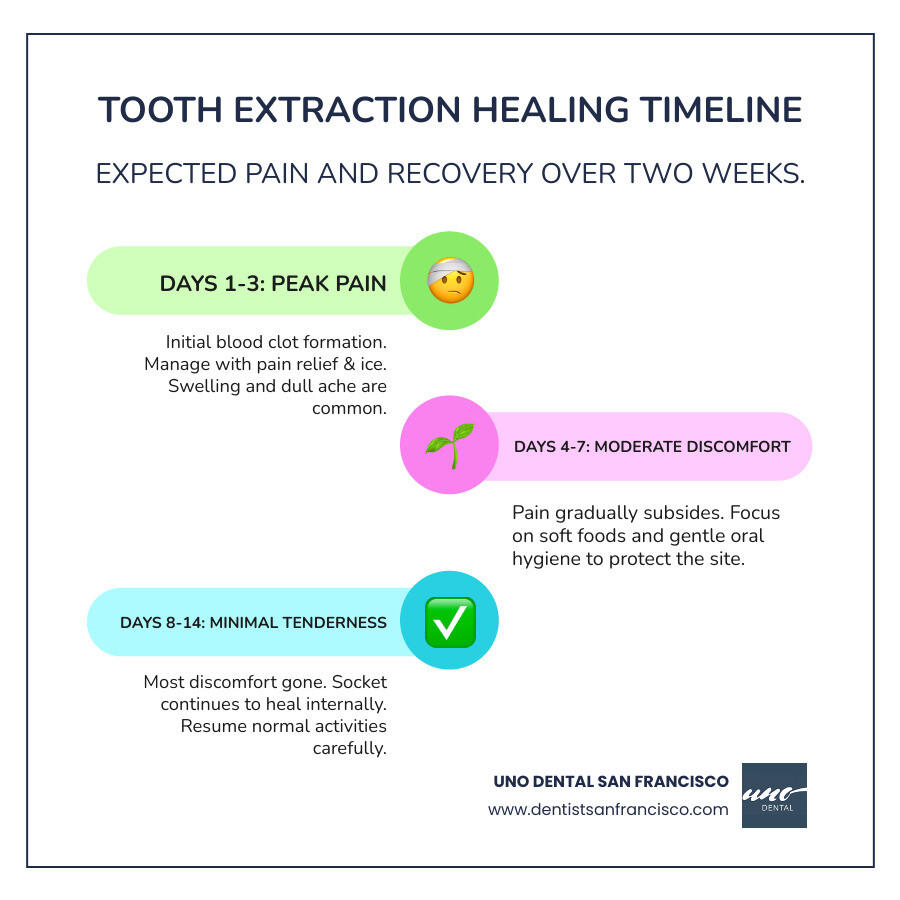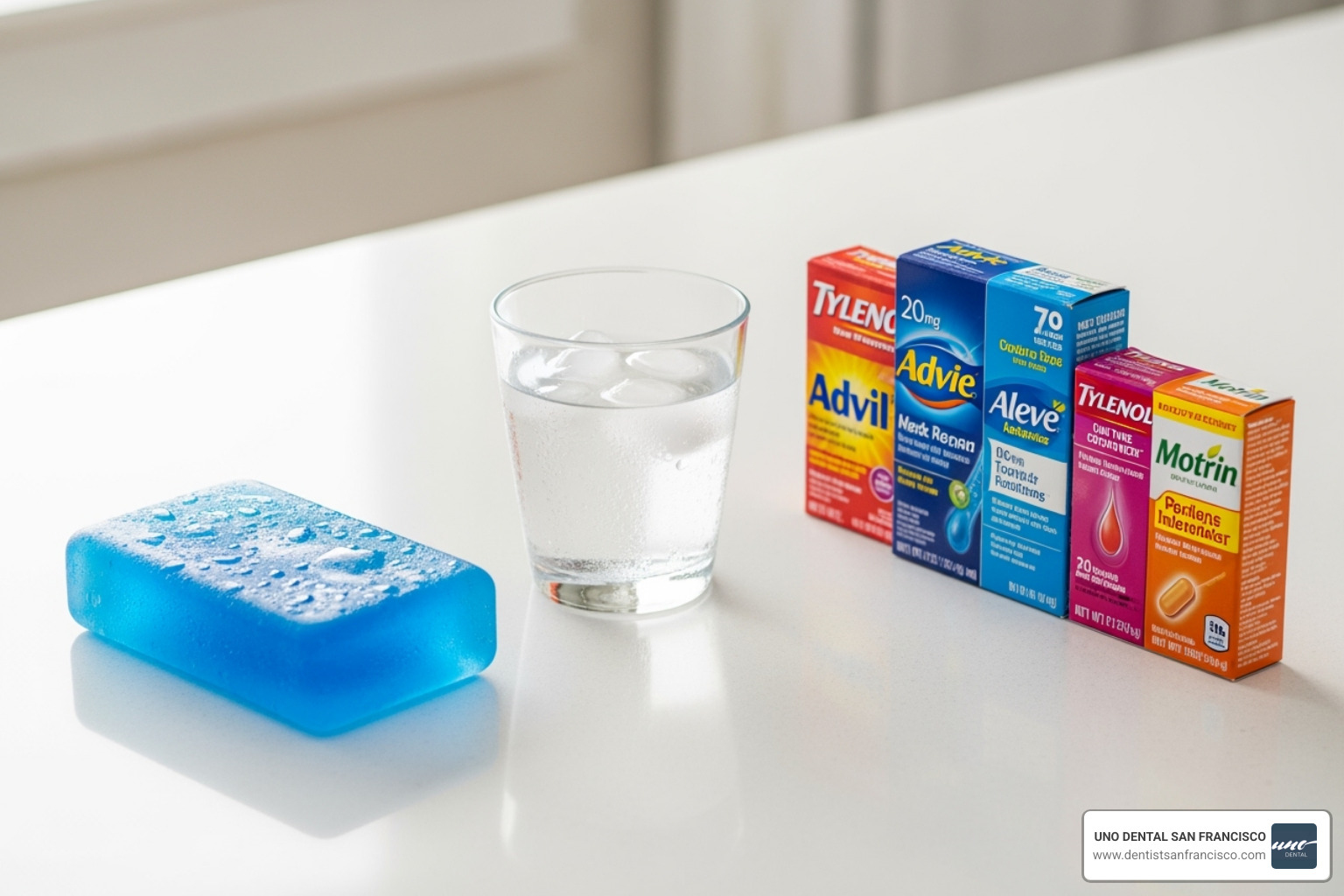
Why Pain Relief After Tooth Extraction Matters
Pain relief after tooth extraction is a top concern, but the good news is that post-procedure discomfort is normal, manageable, and temporary.
Quick Answer: Most Effective Pain Relief After Tooth Extraction
- Combine ibuprofen and acetaminophen every 6 hours (more effective than opioids in most cases)
- Apply ice packs for 20 minutes on, 20 minutes off during the first 24-48 hours
- Rest with your head liftd
- Eat soft, cool foods like yogurt, smoothies, and mashed potatoes
- Avoid straws, smoking, and vigorous rinsing to protect the healing blood clot
The pain you feel is a natural part of the healing process, typically peaking in the first 24-72 hours and gradually improving over the next week.
This guide covers effective pain management, from the best medications to spotting warning signs like dry socket and knowing which activities to avoid.
At UNO DENTAL SAN FRANCISCO, Dr. Mohammad Aghiad Kandar has guided hundreds of patients to comfortable recoveries. Our evidence-based pain relief tooth extraction protocols combine modern techniques with personalized aftercare to ensure your healing is as smooth and safe as possible.
Understanding Post-Extraction Pain and Healing
Immediately after a tooth extraction, your body begins to heal. A blood clot forms in the empty socket, acting as a natural bandage to shield the exposed bone and nerves. This clot is the foundation for new tissue growth. Over the next few weeks, new gum tissue covers the opening, while the underlying jawbone regenerates over several months, especially for larger teeth like molars.
Some discomfort is a normal sign that your body is healing. The key is knowing the difference between normal recovery and a potential complication. At UNO DENTAL, we want you to feel confident about your recovery. For a deeper look at our process, visit our page on the tooth extraction process.
Here's what separates normal healing from signs that something might be wrong:
| Feature | Normal Healing Pain | Complication Pain (Dry Socket/Infection) |
|---|---|---|
| Pain Level | Mild to moderate; gradually decreases | Severe, throbbing, unrelenting; often worsens over time |
| Timing | Begins as anesthesia wears off, peaks 24-72 hours, then improves | Often starts 2-4 days after extraction, or pain significantly increases after initial improvement |
| Appearance | Slight swelling, minimal bruising, blood clot visible (dark red/brown) in socket | Empty socket (no visible blood clot), exposed bone, yellowish/white pus, excessive swelling, redness |
| Other Symptoms | Jaw stiffness, gum tenderness, mild headache, slight discomfort when chewing soft foods | Bad taste/odor, fever (above 101°F / 38°C), radiating pain to ear/eye/neck, swollen lymph nodes |
How Long Does Pain Typically Last?
The first 24 to 72 hours are typically when discomfort and swelling peak. After day three, you should feel steady improvement. Most patients can resume their normal routine within 48 to 72 hours, though some tenderness may persist. While the gums heal visibly within a few weeks, the underlying bone can take months to fully regenerate.
Simple extractions generally heal faster with less discomfort. Surgical extractions, such as for impacted wisdom teeth, involve a more extensive recovery. Our Wisdom Teeth Removal SF guide offers specific information for that procedure.
According to the Oral Health Foundation, most tenderness resolves within one to three days after extraction.
Types of Pain You Might Experience
Post-extraction discomfort can manifest in several ways, all of which are typically normal:
- Dull Ache: A persistent, background discomfort.
- Throbbing Pain: A pulsing sensation, common as anesthesia wears off, that responds well to medication.
- Jaw Stiffness: Tightness in the jaw muscles, which improves with time.
- Gum Tenderness: Sensitivity around the extraction site is expected as tissues heal.
- Radiating Pain: Discomfort can sometimes travel to the ear, temple, or neck due to interconnected facial nerves. This is usually not a sign of a complication.
Immediate and Effective Pain Relief After Tooth Extraction
The key to managing post-extraction discomfort is to be proactive. Take your first dose of pain medication before the local anesthetic wears off to stay ahead of the pain. The first 48 hours are critical for pain management, as this is when inflammation peaks. Proactive pain relief tooth extraction strategies during this window make the biggest difference.
The Best Over-the-Counter Pain Relief for Tooth Extraction
For most dental pain, research shows that a combination of ibuprofen (Advil, Motrin) and acetaminophen (Tylenol) outperforms even opioids. This combination is effective because each medication works differently. Ibuprofen, an NSAID, reduces inflammation directly at the extraction site—the source of the pain. Acetaminophen works on the central nervous system, blocking pain signals from reaching the brain. Together, they attack pain from two angles, providing synergistic relief.
This approach is supported by Scientific research on combination therapy effectiveness, which found this therapy provides more effective relief than opioid medications for dental pain.
For moderate pain, a typical regimen is 800mg of ibuprofen with 500mg of acetaminophen every six to eight hours. However, always follow the specific instructions your dentist provides. The American Dental Association guidelines on oral analgesics provide more detail on this topic.
How to Properly Use Ice Packs and Reduce Swelling
Ice packs are a powerful tool against discomfort. They work by narrowing blood vessels (vasoconstriction), which reduces blood flow to the area. This minimizes swelling and provides a numbing effect.
For the first 24 to 48 hours, apply an ice pack to your cheek following a 20 minutes on, 20 minutes off cycle. Always wrap the ice pack in a thin towel to protect your skin from direct contact. Consistent use during this initial period is key to reducing inflammation.
A Note on Prescription Medications
For severe pain, particularly after complex surgical extractions, your dentist might prescribe an opioid. Opioids change how the brain interprets pain, offering potent relief. However, they carry significant risks, including side effects like dizziness, drowsiness, and nausea, as well as the potential for dependency and addiction, as noted by resources like the Pharmacy Times.
At UNO DENTAL, we reserve opioid prescriptions for cases of extreme pain. We prioritize your safety and will discuss all risks and proper use with you. Managing anxiety during the procedure itself, sometimes with options from our Conscious Sedation Dentistry Complete Guide, can also reduce post-operative pain and the need for stronger medications.
Essential Aftercare to Promote Healing and Prevent Complications
Effective pain relief tooth extraction continues at home. Your daily choices directly impact your healing. The primary goal is to protect the blood clot in the socket, which is the foundation for new tissue. This involves gentle oral hygiene, proper hydration, and following our detailed Resources: Aftercare Instructions: Tooth Extraction Aftercare Instructions.
Your Post-Extraction Diet: What to Eat and Avoid
Your diet for the first few days is crucial for comfortable healing. For the first 24-48 hours, stick to cool, soft foods that require minimal chewing. Good options include yogurt, smoothies (no straws), lukewarm soup, mashed potatoes, and scrambled eggs. For more tips, see our guide on Can I Eat the Same Day After Tooth Extraction?.
Foods and drinks to avoid:
- Crunchy or hard foods (chips, nuts, popcorn) that can traumatize the socket.
- Spicy or hot foods and drinks that can cause irritation and increase swelling.
- Foods with small seeds (berries, rice) that can get stuck in the socket.
- Alcohol, which can interfere with healing and pain medication.
Activities and Actions to Avoid
Certain actions can sabotage your recovery. To protect the blood clot and prevent complications, avoid the following:
- Using straws: The suction can dislodge the blood clot, leading to a painful condition called dry socket.
- Smoking and vaping: This constricts blood vessels, slows healing, and dramatically increases the risk of dry socket.
- Forceful spitting or rinsing: For the first 24 hours, avoid this completely. Afterward, rinse gently by tilting your head and letting water fall from your mouth.
- Strenuous exercise: Avoid for at least 48-72 hours to prevent increased bleeding and throbbing.
- Touching the site: Resist the urge to explore the socket with your tongue or fingers.
When lying down, rest with your head liftd on an extra pillow to help reduce swelling.
Recognizing and Managing Complications Like Dry Socket
While most extractions heal without issue, it's important to recognize signs of complications. If you experience any of the following warning signs, contact us immediately. Early intervention is key to a comfortable recovery.
- Worsening Pain: The biggest red flag is pain that intensifies after 2-3 days or doesn't respond to medication.
- Signs of Infection: Look for a fever over 100.4°F (38°C), pus or drainage from the socket, or swelling that increases after the third day.
- Bad Taste or Odor: A persistent foul taste or smell that doesn't improve with gentle rinsing can signal a problem.
For urgent situations, our Emergency Dentist San Francisco Complete Guide provides additional resources.
What is Dry Socket and How Do I Prevent It?
Dry socket (alveolar osteitis) is the most common post-extraction complication. It occurs when the protective blood clot is dislodged or dissolves too early, exposing the underlying bone and nerves. This results in severe, throbbing pain that can radiate to your ear, eye, or neck, typically starting 2-4 days after the procedure.
Prevention is the best strategy. Protecting the blood clot is paramount to avoid dry socket. Avoid straws, smoking, forceful spitting, and eating hard or crunchy foods. Certain factors like smoking or taking birth control pills can increase your risk, so be sure to discuss your medical history with us.
How is Dry Socket Treated?
If you suspect dry socket, do not try to manage it at home. This condition requires professional care. At UNO DENTAL, treatment involves:
- Cleaning the Socket: We gently numb the area and clean the socket to remove any food or debris.
- Placing a Medicated Dressing: We place a special dressing in the socket. This soothes the exposed nerves, protects the bone, and promotes healing, often providing immediate relief.
- Follow-Up Care: You may need to return for dressing changes. We will provide instructions for pain relief tooth extraction management to keep you comfortable as you heal.
Ignoring dry socket prolongs pain and can lead to infection. If you experience severe pain, our Emergency Tooth Extraction services are available to provide prompt care.
Frequently Asked Questions about Pain Relief for Tooth Extraction
How do ibuprofen and acetaminophen work together for dental pain?
Ibuprofen is an NSAID that reduces inflammation at the extraction site, a primary source of pain. Acetaminophen works differently, acting on the central nervous system to block pain signals from reaching the brain. Taking them together attacks pain from two different pathways, providing synergistic and more effective pain relief tooth extraction than either drug alone.
When should I call my dentist about post-extraction pain?
You should call our office if you experience any of the following:
- Severe, throbbing pain that isn't managed by medication after 2-3 days.
- Pain that worsens instead of gradually improving.
- Signs of an infection like fever, pus, or swelling that increases after day three.
- A persistent bad taste or odor, which could indicate dry socket.
We would rather you call with a concern than suffer at home. Your health is our priority.
Is it safe to use a saltwater rinse after my extraction?
Yes, but you must wait at least 24 hours after your procedure to avoid dislodging the blood clot. After that, you can gently rinse 2-3 times a day, especially after meals, with a solution of a half teaspoon of salt in 8 ounces of warm water. Do not swish or spit forcefully. Instead, tilt your head to let the saltwater flow over the site, then let it drain out of your mouth over a sink.
Your Partner in a Comfortable Recovery
Managing post-extraction pain is about ensuring your peace of mind. This guide provides the information you need for a smooth recovery. Your healing is a partnership between your diligent at-home care and our professional support. Following our evidence-based aftercare instructions—from medication timing to diet—is the key to a comfortable pain relief tooth extraction journey.
At UNO DENTAL SAN FRANCISCO, our commitment to you extends beyond the procedure. We believe in patient-centered care that combines cutting-edge technology with a holistic understanding of your needs. From your initial free virtual smile consultation to your follow-up visits, you'll experience personalized attention that makes a difference.
We provide comprehensive care under one roof, so you have a dedicated team invested in your complete recovery and long-term oral health.
If you're facing an extraction, we encourage you to learn more about our approach to Oral Surgery in San Francisco. Find how our expertise and genuine care create an experience that's as comfortable as possible. We're here for you every step of the way.
Medically reviewed by Dr. Mohammad Aghiad Kandar, DDS



